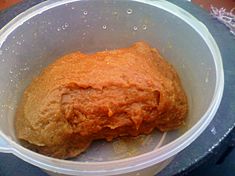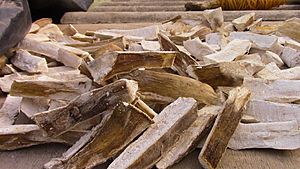Kokonte facts for kids

Balls of kokonte
|
|
| Alternative names | Face The Wall |
|---|---|
| Type | Swallow |
| Course | Stew, Soup |
| Place of origin | Ghana |
| Region or state | Southern |
| Serving temperature | Hot |
| Main ingredients | Dry Cassavaa, Salt and Water |
 |
|
| Alternative names | Abitie, lapiiwa |
|---|---|
| Type | [thick pap) |
| Place of origin | Ghana |
| Region or state | All over Ghana |
| Main ingredients | Cassava |
Kokonte is a popular food eaten in parts of Africa, including Togo and Ghana. It is also known by other names like abeti3, lapiiwa, lapelawa, or “face the wall”. In Ghana, many different groups of people, like the Ga, Akan, and Hausa, enjoy kokonte. It is known for being an affordable meal.
Kokonte can be brown, grey, or deep green. Its color depends on how it is prepared and which group is making it. This dish is usually made from dried cassava or yam.
Konkonte is a Ghanaian dish made from cassava flour. People often eat it with soups, especially those made from palm nuts or groundnuts. It is also popular in other West African countries like Nigeria and even in the Caribbean.
Some people call it "brown fufu" in English. It is quite similar to tapioca, a well-known Brazilian dish that is also popular in the Volta Region of Ghana. Konkonte is a simple dish. It is made from dried and pounded cassava root. Once prepared, it usually looks brown. In Ghana, the Akans are known for making this dish. Its local name comes from the Kwa languages.
Contents
What Konkonte Looks Like
The look of cooked konkonte changes based on the type of cassava used and how well it was dried. It usually has a brownish color. Sometimes, it can even be a deep chocolate-brown. Its color is often compared to the top part of school uniforms worn by students in many parts of Ghana.
What You Need to Make Konkonte
- Dried Cassava or Yam powder
- Water
How to Prepare Konkonte
- First, heat your water until it is hot.
- Then, add your dried powdered cassava or yam to the hot water.
- Stir the mixture very well to make sure it does not get lumpy.
- Keep stirring until the paste turns a deep green, brown, or grayish color.
- Once the color appears, you can serve your konkonte. It tastes great with soups like palm nut soup or groundnut soup.
Making konkonte starts with getting cassava from a farm or market. Cassava is a widely eaten food in Ghana because it is inexpensive. You can buy a small amount of the flour and have enough for a whole family. This same cassava is also used with plantain to make another local Ghanaian dish called fufu.
Getting Cassava Ready (Pre-cooking)
To prepare cassava for eating, you first need to peel it. The peel can be used to feed animals or as fertilizer for farms. After peeling, the edible cassava is washed. Then, it is cut into small pieces called chips. These cassava chips are usually dried in the sun. After drying, they are ground into a powder at a mill.
There are a few ways to dry cassava chips. In Ghana, some farmers use a special drying rack called apa. This rack is often built over a traditional kitchen area called muka. The smoke from the cooking fire helps to dry the cassava chips. This method can make the chips look a bit dark. The best way to dry them is naturally, by spreading the cassava chips on a large tray in direct sunlight.
It is important to dry the cassava chips while they are fresh. If they are left undried for too long, they might develop a brownish color. This can affect the final look of the cooked konkonte. However, some people believe that this browning can actually add to the taste of the konkonte.
Once the chips are dry, they are pounded using a mortar and pestle. Or, they can be taken to a mill to be ground into a fine powder. This powder is what you will cook to make your konkonte dish.
Cooking and Serving Konkonte
You can mix konkonte powder with either room temperature water or hot water. Some people prefer to add hot water to the powder first before cooking. The mixture is stirred on the stove until it gets thick. Then, it is kneaded and cooked more. If it becomes too thick, you can add a little more hot water. Cover it with a lid for a few minutes, then knead it against the pot until the water mixes in well. You might need to repeat this step until you get the right consistency.
There are two common ways to serve konkonte:
- Serving Method 1: Once it is cooked, wet a deep bowl with a little water. Scoop a portion of konkonte into the middle of the bowl. Pull all the edges of the konkonte towards the center. This will create a smooth base. Then, flip the bowl over. You will have a smooth ball of konkonte ready for your soup.
- Serving Method 2: Some people simply scoop a portion of konkonte into a bowl and pour their soup over it.
See also
 In Spanish: Konkote para niños
In Spanish: Konkote para niños



